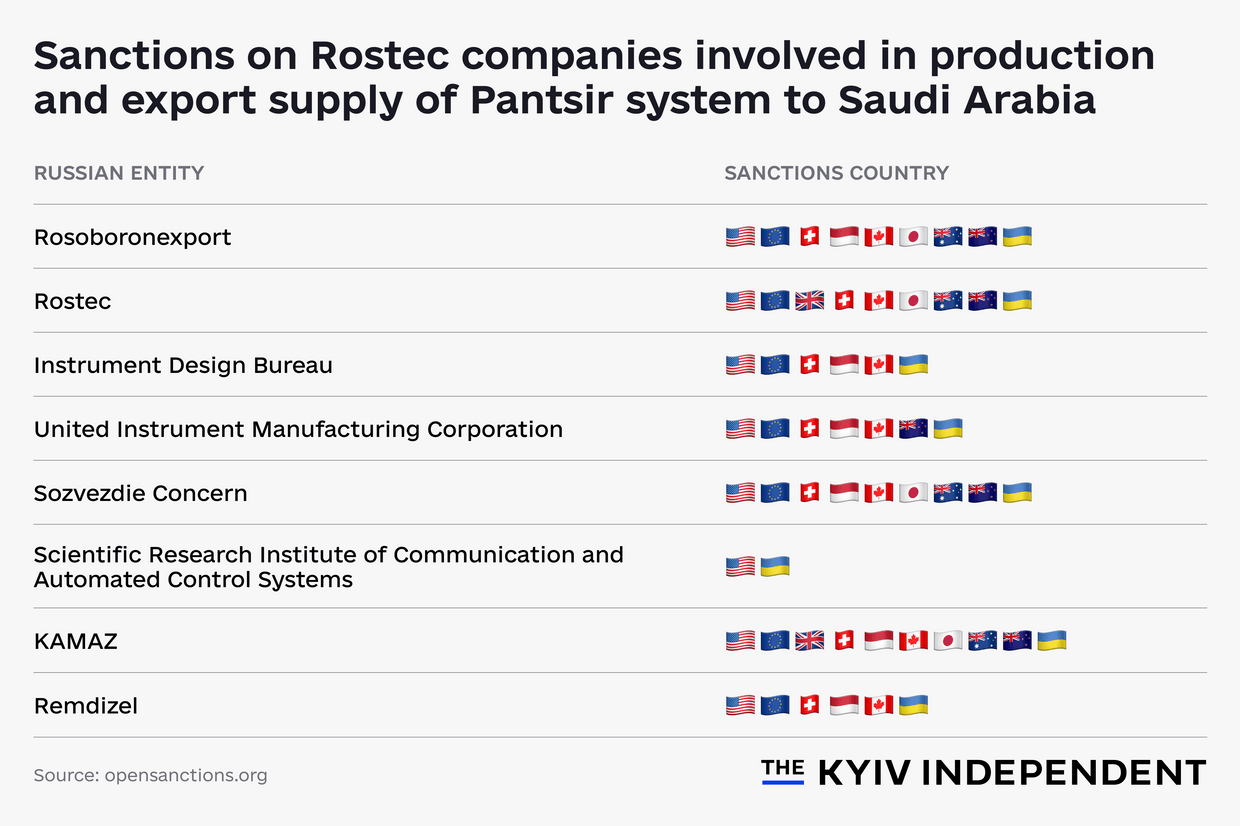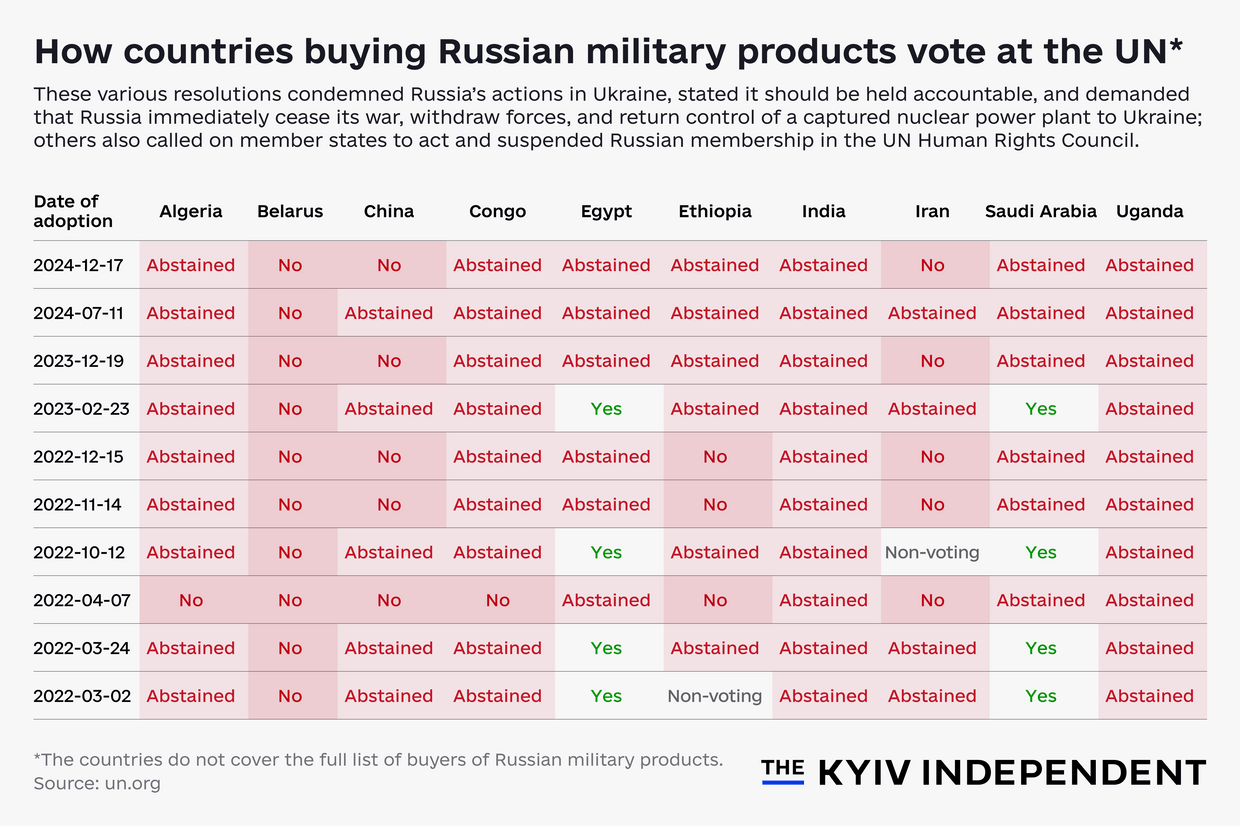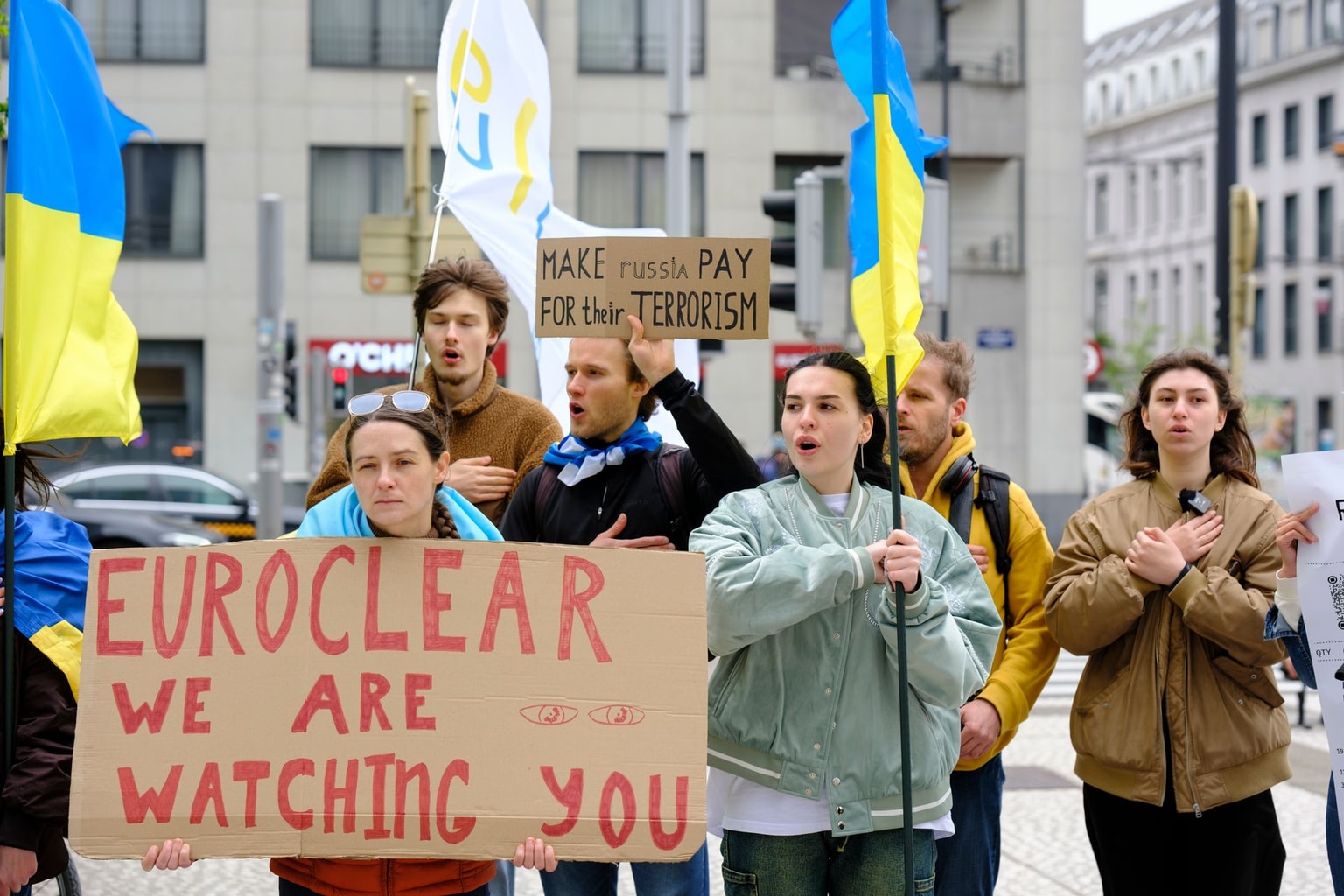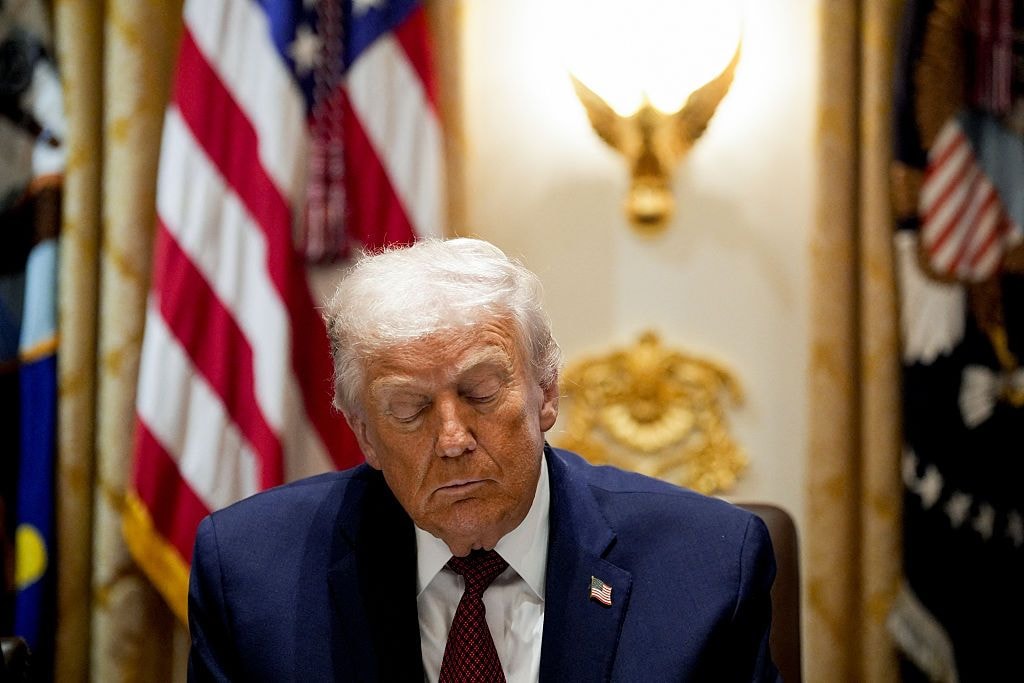
Investigation: Russia profits from arms exports to Saudi Arabia despite sanctions, leaks reveal
Leaked documents offer a look into Russia's efforts to sell weapons abroad during its war against Ukraine to generate cash and grow influence.
A collage of the Pantsir missile system (C), a screenshot of the invoice from Rosoboronexport, and portraits of Russian President Vladimir Putin (L) and Saudi Arabia's Crown Prince Mohammed Bin Salman (R). (Irynka Hromotska / The Kyiv Independent). Photo of Vladimir Putin by Contributor/Getty Images; Photo of Mohammed Bin Salman by Ludovic Marin / POOL / AFP via Getty Images.
Few agreements are shrouded in more secrecy than inter-government arms deals — especially when one of the parties is a global pariah leading a bloody war.
But a recent massive leak of emails and documents has given us an unprecedented glimpse into a particularly secretive transaction.
The leak reveals that Saudi Arabia agreed to pay Russia over 2 billion euros under a contract signed in 2021 involving companies that were repeatedly sanctioned, both before and after Russia’s full-scale invasion of Ukraine.
Saudi Arabia doesn’t appear to have canceled the contract after the invasion started, despite the risk of repercussions from the U.S. — a major supplier of weapons to Saudi Arabia.
Data included in the leak also shows that Russia has continued to sell arms to up to a dozen countries since the start of its invasion of Ukraine, bolstering its defense production and war effort.
Apart from Saudi Arabia, the documents reveal contracts with traditional buyers of Russian weapons, such as India, China, or Algeria, none of which have stopped buying arms from Russia.
The Kyiv Independent, in partnership with OCCRP, obtained a leak containing thousands of internal emails of Ruselectronics, a subsidiary of Russia's state arms giant Rostec.
Arms exports have traditionally been one of Russia’s biggest sources of revenue, although far behind oil and gas. These revenues are now being used to support Russia’s war against Ukraine.
Sanctions imposed after the start of Russia’s full-scale invasion of Ukraine have significantly reduced the country’s arms exports. Still, Russia has managed to continue trade with a dozen countries that have not imposed sanctions on Moscow, making it the world’s third-largest weapons exporter in 2023.
The leak reveals the relentless efforts of Russian arms manufacturers to sustain exports during the war.
Exports help support Russia’s arms industry and fuel its war machine, despite numerous sanctions imposed over its assault on Ukraine. Analysts say the sales also serve as Russia’s “tool of influence,” strengthening its alliances and helping it secure votes at the United Nations. Russia may have even obtained access to Western weapons technologies through its arms sales to Saudi Arabia.

Decoding the secretive Project 82P
Even in internal documentation and letters, Russia maintains some secrecy when it comes to the foreign governments who buy their weapons.
As the leak shows, instead of directly naming the countries that purchase their military products, Russia uses a system that assigns a code to foreign countries, known in Russian as the “All-Russian Classifier of Countries of the World.”
For example, “foreign customer 012” stands for Algeria. In 2022, Russia was going to supply Algeria with its Acacia-E automatic aerospace defense system, according to the leak.
When reporting on deliveries of the Post-3M radio reconnaissance station to Iran in 2021, the letters describe the buyer as “foreign customer 364.”
When mentioning the supply of Polyana-D4M1 command and control system to Egypt, planned for 2025, they code the buyer as "foreign customer 818."
Yet not all the codes are so easy to decipher.
The leak contains a contract encoded in a special way — Project 82P. There is no such country code as “82P,” and the client country isn’t mentioned in almost any of the letters that concerned the project. It appears that this contract was more sensitive than others.
"All the information related to interaction with the foreign customer specified in the contract is subject to restriction," one of the letters on Project 82P reads. It also says that to keep the details of the contract secret, Russia planned to sign separate confidentiality agreements with the banks involved in the project.
Having analyzed hundreds of letters mentioning Project 82P, the Kyiv Independent can confirm that this code stands for an agreement with Saudi Arabia to supply Pantsir air defense systems. The "82" is a part of the country code for Saudi Arabia (682), and the letter "P" could be referring to the product name — Pantsir.
Within the contract, the Russian side was to supply Saudi Arabia with the Russian Pantsir-S1M system and provide additional services related to it.
The Pantsir is a self-propelled air defense missile and gun system. It can shoot down missiles, airplanes, helicopters, aerial bombs, and drones.
The system itself is a large truck equipped with missiles and anti-aircraft guns, which can be used alone or in battery together with a command post and radar truck.
It recently gained notoriety, as a Russian Pantsir-S battery is alleged to have brought down the Azerbaijan Airlines flight on Dec. 25, killing 38 people.

2 billion euros for Russian military production
While the deal was secret, some evidence surfaced in 2024 that Saudi Arabia obtained Russia’s Pantsir systems.
In February 2024, a photo appeared online showing a man, allegedly a Saudi soldier, posing next to a Pantsir with a training certificate in his hand. At the end of the year, the Saudi Air Defense’s Bulletin listed the Pantsir among its new air defense systems. No other details were provided.
With the leaked Ruselectronics emails, the Kyiv Independent can piece together how Saudi Arabia obtained the Russian air defense systems.
The emails reveal not only the high value of the contract but also how Saudi money flows directly to Russian military companies united under the Rostec brand.
According to the leaked documents, Saudi Arabia agreed to pay 2.17 billion euros for the supply of Pantsir batteries, additional equipment and ammunition, and the training of operators.
A battery is a military tactical unit consisting of several pieces of artillery working together. A Pantsir battery usually includes up to six pieces.
According to various references to the contract found in the leaked emails, Saudi Arabia ordered anywhere from six to 10 Pantsir batteries.
Newly revealed details of the Saudi-Russian contract
In more detail, the contract description includes 39 combat vehicles, 10 command post units, nine radio command vehicles, 20 loader vehicles, hundreds of missiles, and tens of thousands of cartridges.
To maintain the Pantsirs, Saudi Arabia also ordered seven repair vehicles, five evacuation trucks, seven fuel servicing trucks, seven storage and transportation vehicles, and other equipment.
They bought various simulators to train the Saudi military and planned three training rounds.
The contract was signed on April 8, 2021, and was expected to last 58 months — that is, until 2026.
The Saudi Defense Ministry made an advance payment of 15% of the contract, or 326 million euros, on Aug. 5, 2021, feeding the Russian military machine with cash just six months before Russia's full-scale invasion of Ukraine.
Delivery of the first batch of the air defense systems and related equipment was scheduled for the end of 2023.
International trade records found in the ImportGenius database show that at the end of November 2023, Rosoboronexport made two shipments of four units of “new special purpose motor vehicles” to Saudi Arabia. The description is vague but the trademark of the vehicles, the names of Russian shippers and a Saudi consignee, and the cargo delivery point — an air defense base in Jeddah — indicate that the vehicles were supplied under the Pantsir contract.
The leaked Russian documents also show how many subsidiaries of the Russian arms conglomerate Rostec, which is sanctioned by many countries for its role in the war against Ukraine, benefit from the Pantsir exports.
Here’s how Saudi money moved through the Russian arms holding. The advance payment went from the Saudi Defense Ministry to Rosoboronexport.
This state company, a part of the Rostec conglomerate, acts as an intermediary for all of Russia's military exports and imports, receives payments, takes a commission for contract management, and subsequently transfers the rest of the money to the contractors.
Following receipt of the advance payment, Rosoboronexport distributed the bulk of the funds to state-owned Russian arms producers — Shipunov Design Bureau, known as the developer of the Pantsir complex, United Instrument Manufacturing Corporation (also known under its Russian acronym, OPK), the managing company of the Ruselectronics holding, Sozvezdie Concern, the Scientific Research Institute of Communication and Automated Control Systems (NIISSU), the truck producer KAMAZ’ subsidiary Remdizel and others.
Each entity has a role in the contract. For example, OPK has been appointed as the radio command vehicles supplier, while Sozvezdie Concern and NIISSU are its main co-executors. Russian KAMAZ and its subsidiary Remdizel produce the chassis for the system.
All these companies are currently subject to numerous international sanctions either for their role in the deployment of Russian military technologies on the battlefield in Ukraine or for providing a substantial source of revenue to the Russian government during the war.
Rosoboronexport has also been repeatedly subject to U.S. sanctions within a nonproliferation program against Iran, Syria, and North Korea. The latest Iran-related sanctions were imposed on Rosoboronexport in 2023. Rostec was subject to U.S. sanctions before 2022, including for its connection with Russia's invasion of Ukraine in 2014 and military cooperation with China.

The transfer of Russian technology to Saudi Arabia
According to the leak, the delivery of Pantsir batteries and additional equipment is only part of the 82P Project.
In addition to the 2-billion-euro contract, the documents describing the project mention a second major part of the cooperation. The contract for it, even three contracts, was not yet signed in the first half of 2022, but was already being discussed.
This includes localizing Russian Pantsir systems production in Saudi Arabia, establishing maintenance centers in the country, and creating a training center.
The future localization of production was Saudi Arabia's requirement to sign the first contract to supply air defense systems.
A leaked letter titled “Localization Plan” contains a 69-page document entitled Proposal for the Localization of the Pantsir-S1M Complex Production. The proposal includes three localization programs.
The first describes the large-scale assembly of 15 Pantsir batteries in Saudi Arabia.
The second localization program establishes a network of service centers for Pantsir maintenance (five regional and one central repair workshop).
The third program involves building a training center in Jeddah, Saudi Arabia's second-largest city and "economic capital." The center would require the construction of a 15,000-square-metre study building.
Although none of the three contracts had been signed during the time period covered by the leak, the leaked documents mentioned that Saudi Arabia was ready to sign the assembling production contract in the second half of 2022.
If the contracts were indeed signed, Russia could receive even more than 2 billion euros from Saudi Arabia over the next few years.
Russia's war with Ukraine, though, could have affected the fate of any joint Pantsir assembly in Saudi Arabia, as the war has allegedly already affected a couple of other Russian export contracts.
"There was a report that Russia had taken away the shells made for Azerbaijan because it needed them in the war against Ukraine," Ivan Kirichevsky, an analyst at Defense Express, reported. "Another report indicates that Russian T-90S export tanks intended to be sold to India, Algeria, or Vietnam were also spotted on the battlefield in Ukraine. So there are some doubts as to whether Russians can reach the next stage of the Saudi contract — the organization of joint production. They are now highly dependent on imports of various equipment and electronic components. This may affect co-production arrangements."
A pathway to Western military tech
The Pantsir contract carries with it the risk of Russia becoming familiar with Western technologies through its cooperation with Saudi Arabia. The country is a major buyer of U.S. weaponry and buys arms from South Korea and EU countries, including air defense systems.
"Saudi Arabia is one of the major operators of Patriot systems. Whether the Russians could have gained access to them is a sensitive issue," said Ivan Kirichevsky, an analyst at Defense Express, a Kyiv-based military think tank. "The U.S. has demonstrated that it is sensitive to the risk of transferring its technology to third parties.”
Kirichevsky cites the example of Turkey. In 2020, four months before the Russian-Saudi agreement was signed, the U.S. slapped sanctions on Turkey over a purchase of the Russian S-400 missile system.
The risk of Russians accessing U.S. technology is high since the Project 82P also includes “integration” services, meaning integrating the Pantsir complex into Saudi Arabia's command, communications, and intelligence system.

Those services would be performed by Russian specialists, who could obtain access to the existing Saudi arsenal, which is stuffed with U.S. weapons.
Moreover, Russia appeared to have asked for this access.
In October 2021, some six months after signing the contract, Saudi Arabia's representatives met with the Russian side in Moscow to discuss the execution of Project 82P. The Kyiv Independent found the meeting’s minutes in Russian companies’ emails.
The emails mention an upcoming trip by Russian representatives to Jeddah in Saudi Arabia, scheduled for May 2022. While discussing the meeting, the Russian side requested to visit Saudi air defense facilities — and received consent. They started making preparations for the trip like booking the hotel, car rental, and buying tickets.
The obtained email leak covers the time up until May 2022, the same month when the trip was supposed to take place. While the Kyiv Independent can’t confirm that the trip took place, there was no sign it was canceled either.
The Saudi Defense Ministry did not respond to a written inquiry from the Kyiv Independent.
Why is Russia selling air defense while waging war with Ukraine?
Russia’s efforts show it’s highly interested in selling arms and military technology abroad, despite its massive need for weapons for its war against Ukraine.
According to one of the leaked letters, in June 2022, four months after the start of the full-scale invasion of Ukraine, state arms exporter Rosoboronexport held a three-day meeting with arms manufacturers in St. Petersburg. The event was private, with no public mentions of it.
The topic was promoting Russia's anti-unmanned aerial vehicle (UAV) equipment "with high export potential." A Rosoboronexport representative held a presentation on how export sales could be boosted.
Two months later, in August 2022, Rosoboronexport hosted a different event, this time a public one. Its seven-day International Military-Technical Forum aimed to secure new arms sales contracts. It reportedly attracted delegations from 50 countries.
Local media made no secret of Russia’s efforts to interest foreign delegations in a wide range of military products, including tanks, armored vehicles, UAVs and anti-UAVs, air defense systems, rifles, mortars, and fighter aircraft. Similar events were held in 2023 and 2024 and are planned for 2025.
Trying so hard to sell weapons abroad while leading a resource-demanding war may seem like an odd thing to do but there are at least two good reasons for Russia to pursue it: high export revenue and strengthening geopolitical ties.
Arms under export contracts are traditionally sold at a higher price than those supplied to the domestic army.
"The policy of arms export contracts is always the same: You sell your products to someone for export at a premium to supply your army at a lower cost," said Kirichevsky, an analyst at Defense Express. "The price of the 2 billion euros for six Pantsir batteries seems very high, even when it includes additional equipment and training for the military."
Although Russia’s export capacity started crumbling after the start of Russia’s invasion of Ukraine, it remained a significant exporter of military products. The Stockholm International Peace Research Institute (SIPRI) compared data on Russian arms exports for two periods: 2014-2018 and 2019-2023. The institute found that, between those two periods, the volume of Russian arms exports fell by 53%. The number of countries willing to buy Russian arms has also decreased, but 12 countries were still buying Russian weapons in 2023.
Leaked letters show that Rosoboronexport received new export inquiries after Russia's invasion of Ukraine.
In spring 2022, soon after the world learned about the Russian massacre of civilians in Ukraine’s Bucha and other places, the Russian defense conglomerate received new inquiries from potential clients.
The leaked emails show that Armenia inquired about a possible delivery of the Ranzhir-M1, a command center unit for air defense systems. Meanwhile, Venezuela was interested in Pishchal-Pro and Kupol complexes, the systems that take down unmanned aerial vehicles, or UAVs.
The Kyiv Independent was unable to find confirmation of such deliveries in public sources, or in the customs records available through leaks.
Russia also continued to work on executing contracts signed in previous years. There are no mentions of any contracts canceled by either side after the start of the invasion.
In 2022, Rostec worked on contracts with China, India, Algeria, Egypt, Belarus, and several other countries, all of which continued to receive military supplies from Russia after its full-scale invasion of Ukraine and new sanctions against the Russian defense companies.
Experts say that Russia is motivated to sell its weapons abroad not only by money but by the prospect of establishing or strengthening of geopolitical ties.
"Russia sees arms sales as another tool of statecraft. It's a tactic," Anna Borshchevskaya, a senior fellow with the Washington Institute for Near East Policy, says. "It's not independent of foreign policy, and so arms sales will strengthen bilateral ties between countries on a political level. It's a tool of influence from the Russian perspective."
According to Agiya Zagrebelska, a Ukrainian sanctions expert and representative of the NGO Economic Security Council of Ukraine, the result of such ties can be seen in the countries' votes at the UN.
Although the allegiance to Russia is not as clear as in the case of Belarus, China, or Iran, Saudi Arabia has abstained from more than half of the UN votes for resolutions on Russia's war against Ukraine. (See the chart)

On the one hand, the country voted for the withdrawal of Russian troops from Ukraine. However, it abstained from voting on resolutions on the suspension of Russia’s rights of membership in the Human Rights Council and on remedy and reparation for aggression against Ukraine.
Saudi Arabia has also helped to free foreigners imprisoned by the Russian military and brought together 42 countries in Jeddah to find ways to end the Russian war in Ukraine. It has also allegedly threatened the G7 against seizing Russia’s frozen assets, according to Bloomberg’s sources.
The country has also promised to provide Ukraine with $400 million in humanitarian aid while pledging billions to Russia’s military enterprises.
Yet even with rich clients like Saudi Arabia, the volume of Russia’s arms exports has fallen in recent years.
Due to Western sanctions, it has become both difficult and costly for Russia to import Western equipment and electronic components it still needs for defense production. Some reports also suggest that Russia deployed some of the weapons meant for export to the front line in Ukraine.
This makes Russia an increasingly problematic supplier.
Note from the author:
Hey! This is Alisa Yurchenko, the author of this story. Thank you for reading it.
I spent the past two months reading leaked internal correspondence of Russian state defense companies. The letters were scattered and out of order, so I had to reconstruct their timeline like a jigsaw puzzle.
But it was all worth it. I was glad to reveal how many sanctioned Russian military companies profit from a major arms export deal.
Understanding this is crucial as such deals bolster Russian defense industry and the country’s geopolitical standing — all while Russia is waging a full-scale war.
We are not done with this particular leak, however. We are still analyzing it and will soon share insights about Russia's efforts to source foreign components for its defense industry.
Please consider supporting the Kyiv Independent by becoming a member or making a one-time donation. It is our readers’ support that makes our work possible. Thank you!









